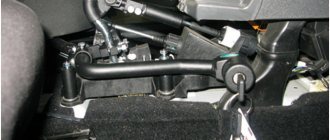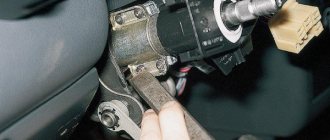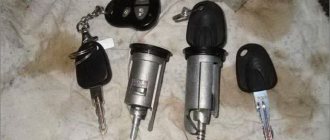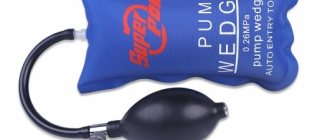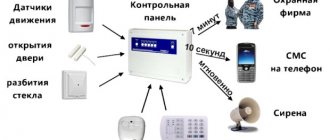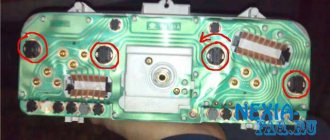How to defrost a car door lock in cold weather
So, let's look at the listed and other methods of opening locks in more detail, providing comprehensive information.
Method one. Checking locks
The simplest thing a car owner can do when it turns out that the driver’s door won’t open because the lock is frozen is to check the functionality of the locks on other doors. If you own an SUV or a hatchback or station wagon, then also check the lock on the trunk. With proper dexterity and average physical fitness, you can easily get into the cabin through the trunk.
These are the steps you should take first. Next, if you managed to open at least one of the doors and you climbed into the driver’s seat, start the car and turn on the heater. The lock will gradually thaw under the influence of hot air. For the same purpose, you can use a hair dryer, which is of little use for removing ice on glass, but is just right for spot heating of surfaces.
Do not attempt to open a frozen door from the inside until the lock has thawed. Moreover, there is no need to do this using brute physical force. This can damage the lock mechanism, including its electronic part, as well as the rubber seals on the doors.
Method two. Key rotation
If you managed to insert the key all the way, but the lock does not turn, you can try the following steps simultaneously:
- rotate the key in different directions (right-left);
- tap the area of the door under which the lock mechanism is located.
However, you should not be too zealous, since the metal from which the key is made becomes brittle in the cold and can be broken.
If you feel that the amplitude of rotation increases with each movement, then you are doing everything correctly, and after a while the lock will open. The described operations can be performed not only on the driver's door, but also on other doors, including the trunk (in the case of a hatchback or station wagon).
Method three. Heat the key
This method is a continuation of the previous one. So, if the above actions did not lead you to the desired result, you can heat the key using an open fire source. To do this, use matches or a lighter. The time between heating and the moment when you insert the key into the keyhole should be minimal so that the metal from which the key is made does not cool down in the cold. If necessary, you can repeat the heating procedure and trying to turn the key several times. If on the next cycle the key begins to turn more, then you are on the right track.
However, do not overheat the key tip too much. Firstly, because of this, the metal can become covered with soot and become more fragile, and secondly, the plastic body of the key handle can be damaged, and what is even more dangerous, the electronics located in it.
There are several more life hacks in this aspect. Firstly, you can use other long metal objects instead of a key. For example, women can use hairpins for this purpose, and men can use a tie clip. However, remember that heat spreads evenly throughout the metal, so you risk burning your fingers during the heating process. Therefore, it is better to wear a glove or use some kind of cloth on the hand with which you are holding a metal object.
Secondly, if you use a regular lighter, then over time its metal part will also heat up and it will be impossible to hold it. Therefore, in order to use the lighter on for a long time, you can use some kind of rubber band. This could be a hair tie, for wrapping money, or even a cut condom!
To protect the paint near the keyhole, use a piece of foil or cloth that should be placed around it.
Therefore, the optimal algorithm of actions for the third method will be as follows:
- Grasp the long metal object on one side with your gloved hand.
- Light the lighter and use a rubber band to secure the gas button so that it works in long-term mode.
- Insert a metal object into the lock cylinder while simultaneously heating the metal with a lighter.
The operation can last up to several minutes. The main thing is that the flame on the lighter does not go out. Don't forget to follow safety rules to avoid damaging your car's paintwork and getting burned!
Method four. Using open fire
It’s worth mentioning right away that this method can only be used as a last resort, since there is a real risk of damage to the paintwork of the door, as well as burns.
To implement the method, set fire to any long object (a stick, rolled paper, etc.), after which, with its help, the fire is placed as close as possible to the frozen castle. The most effective option in this case is to use a lighter with a directed fire (the so-called continuous lighters or lighters with a turbocharged flame).
In this case, you need to act extremely carefully so as not to damage the paintwork of the car and not get your fingers burned.
A safer method to melt the ice from a keyhole is to present a smoldering cigarette.
Method five. Direct heating of the lock cylinder
There are several options here. First of all, there is a division into coolants and methods of their delivery. As for the former, water or hot sand is used as heated substances (the most common options, although other bulk elements, such as table or sea salt, can be used instead of sand). Accordingly, the coolant must be preheated (in a kettle, in a frying pan or other similar surface), and then placed in a vessel so that the thermal energy is subsequently transferred to the frozen lock.
As for the coolant container, you can use various options for this - a plastic bottle, an inflatable ball, a piece of fabric, a thick plastic bag, and so on. When choosing a particular carrier, take into account not only the fact that at high temperatures its strength decreases (this is especially true for products made of plastic film - bags, balls and bottles), but also the volume of the coolant. The more it is, the greater the load the material experiences.
As practice shows, defrosting a car lock using such improvised means is a completely feasible practice. The main thing is to choose the optimal volume of coolant and follow safety rules. In particular, so as not to get burned yourself.
Method six. Using heating elements or appliances
Using a hair dryer to defrost a lock
First of all, we are talking about a household or industrial hair dryer. However, there are a number of inconveniences and features. In particular, to connect this electrical device, you need not only a single-phase 220 V network, but also an extension cord of sufficient length to connect the electrical device to it. You also need to be careful not to use a hairdryer that is too powerful to treat the car’s paintwork, as it may be damaged. This is especially true for powerful construction hair dryers, so their use remains in doubt or the personal choice of one or another car owner.
As for a household hair dryer, it can be used in a wider range, since it does not create such a high temperature and does not transmit such powerful thermal energy. However, it must also be used safely for paintwork. The main thing you must remember is that you cannot get rid of ice very quickly. It is necessary to be patient and wait a while so that the ice comes off on its own under the influence of thermal air.
Method seven. Using a lock defrost
The most “civilized” effective method in the case when the car door lock is jammed due to frost is the use of special means - defrosters. Today there are a huge number of these compositions. However, their range differs in different regions of the country, since it depends on logistics and prices.
Lock defroster. Which product should I choose?
The best defrost for HI Gear locks, but there are also 9 more products that are worth paying attention to. The defrosting agent will help you quickly open the car door even at -35 degrees below zero.
You can read the exact algorithm for using a particular defroster in the instructions for the corresponding product. However, the use of most of them comes down to the fact that, with the help of a “spout” or tube, its composition is carried into the internal mechanisms of the lock parts, where its chemical composition begins to directly defrost the formed ice.
Most defrosting products are based on an alcohol base, which, when interacting with any surface, including an icy surface, emits thermal energy, due to which defrosting is performed.
When the first cold weather sets in, try to always buy a similar product for yourself and carry it with you (in your pocket, bag, but not in the car!). It is best to buy aerosol defrosters as they are more effective.
Instead of factory means for defrosting the lock, you can use other improvised means. For example, medical alcohol (alcohol-containing liquids), antifreeze or antifreeze. However, you will need a syringe for this. Any of the listed liquids is taken into it, heated in the palm of the hand and poured into the lock cylinder.
How to defrost a car lock
Additional Methods
In addition to the main defrosting methods listed above, there are also additional methods for defrosting a car lock. In particular, a somewhat unusual method is to use a rubber hose to direct exhaust gases from a running car towards the frozen lock. In this case, it is desirable that the hose be of short length, since otherwise the temperature of the exhaust gases during their transportation will drop and the procedure will lose its meaning.
When using this method, follow safety regulations, as exhaust gases are dangerous to human health!
Well, the worst option, when the methods described above did not help, is to call a tow truck and transport the car to a warmer place. By the way, it is possible that the lock was not just frozen, but that its electronic part failed in the cold. In this case, simply warming up the lock will not work. The intervention of appropriate specialists will be necessary.
What should motorists do in the cold?
1. The most common problem is that the car does not want to come out after a night of hibernation, as if it had frozen to death. The battery's power is sharply reduced in cold weather, so it does not rotate the starter at a speed that allows the engine to start. There are several ways to avoid disaster, all of which involve a lot of hassle. You can get up at night by the alarm clock and warm up your pet, you can remove and drag the battery into the apartment for the night. The last method is available only to those who clearly know how to properly remove and replace the battery. Operating a car in winter A less painful option: wrap the battery in a cloth that has good thermal insulation properties. You can do this at night, or you can do it during the day if the frosts are severe and the car is parked outside for a long time. Practice shows that this method helps at minus 30°C.
How to defrost doors
If you manage to defrost the lock, then it is not a fact that you will immediately be able to open the car door. The fact is that there is a high probability that ice has appeared on the rubber seals, which prevents the doors from opening. There are several methods to correct the situation.
The first thing to do is check all the doors. You may be able to open one of the passenger doors or the trunk without any problems. You can easily climb over them to the driver's seat. Second, try pulling the door a little harder. However, you should not be extremely zealous, because with great effort you risk breaking the door handle or tearing the rubber seals. Third, instead of pulling the doors toward you, try pushing them inward. With significant force, there is a possibility that the ice will break.
After this, it is recommended to knock on the door body along the line of the seal. The impacts must be of medium magnitude so that the transmitted force can destroy the crystal lattice of the ice. However, you shouldn’t be too zealous so as not to leave dents on the body. The number of blows should be large, and their places of application should be located close to each other. After completing this procedure, try opening the doors again.
For hatchback or station wagon cars, there is another method for opening the driver's or passenger door. But provided that the trunk door is opened. To do this, you need to sharply close it several times. At the same time, excessive pressure is created in the cabin for a moment, which acts on the doors from the inside. And this force can destroy the ice on the seals.
After you have opened the doors, wipe the seals dry with a rag. And then be sure to treat the rubber door seals with silicone grease. It will not only protect the doors from freezing, but will also extend the life of the rubber bands and restore their former softness.
Types of defroster - key fob, lubricant, liquid
In any auto parts store or just in a large chain supermarket you can find a variety of devices that the manufacturer qualifies as a car lock defroster. They can be roughly divided into three categories:
- electric lock defroster (key fob);
- liquid formulations;
- aerosols.
The so-called “key fob lock defroster” acts as a miniature electric heater. Inside the device there is a metal rod, which, when the key fob is turned on, extends and heats up to almost 200 degrees. This way you can defrost any lock. However, this method will not save you from repeating this problem the next morning. Moreover, it is possible that you may accidentally damage the paint surface around the lock with a heated element.
Liquid car lock defroster is not a very tricky or expensive product. As a rule, this is a small plastic bottle with a thin spout. You simply open the composition, move the curtain of the lock cylinder with the spout, and pour the liquid inside. Then you wait. As a rule, after 2-5 minutes the door can be opened. But in the case of a liquid composition, there is one big disadvantage! When the curtain of the lock is frozen, you will not be able to defrost the lock with it.
Comparison table for lock defrosting methods:
| Lock defrosting method | pros | Minuses |
| Keychain | + Fast; + Always with you | — It’s inconvenient to carry car keys; — It is possible to get burned when used/accidentally activated in your pocket; — Possible damage to the paintwork; — Batteries may run out; — Requires reuse; — Price |
| Liquid | + Relatively fast; + It is difficult to damage the mechanism/paint coating | — If the curtain of the mask is frozen, it is impossible to use it; — Aggressive composition; - Requires reuse |
| Aerosol | + Re-use the next day is not required, the layer is preserved; + Suitable for both prevention the day before the door is expected to freeze, and for urgent measures to defrost the lock; + Fast; + It is difficult to damage the mechanism/paint; + You can also treat rubber door seals and other surfaces | — You need to check the weather forecast to prevent freezing the next day; — Price |
| “Folk methods”, for example, watering a castle from a teapot | + Always eat at home; + Fast | — Doesn’t always work; — In inexperienced hands it will damage the mechanism; — Possible damage to the paintwork; - Requires reuse |
That’s why the most effective lock defroster with silicone lubricant is considered an aerosol. This product will not spoil the paint; it quickly evaporates from the surface, leaving a protective invisible film.
Important to remember!
It’s easy to buy a lock defroster, it’s very simple to use, but none of these remedies will save you from repeating the problem the next day, after washing the car or wet snow and frost. And if you don’t want to deal with frozen locks, doors or glass every time in winter, then you just need to treat them with a more innovative product. Prevention of any disease is always cheaper and more effective than treatment!
Prevention
There are several simple prevention tips that will allow you to avoid problems with opening a frozen lock. In particular, in the fall, buy the following products:
- lock defroster (described above);
- door antifreeze;
- door hinge lubricant.
Many lock defrosters contain silicone and technical oils. Thanks to them, these products not only allow you to melt the ice in the internal locking mechanisms, but also ensure their better interaction. Therefore, it is recommended to periodically use lock defrosters for preventive purposes (apply the product to locks in their normal working condition). However, this only makes sense if the defrost contains silicone, Teflon and/or technical oils. You can read the composition of the product on its packaging or the accompanying instructions. As a last resort, ask the seller about it.
It is especially recommended to lubricate the lock cylinder for preventive purposes before washing in winter. Or during significant frosts (including in situations where, according to the forecast, a significant cold snap is expected).
Rubber seals on the doors also need to be treated with silicone lubricant. It will not only prevent the doors from freezing to the car body, but will also extend their service life.
It is recommended to use silicone grease on rubber seals, dashboards, hinges and other plastic and rubber elements, including in summer. This is done, firstly, to increase their service life, and secondly, to eliminate squeaks, if any.
By the way, instead of defrosters for the larvae, you can use brake fluid or motor oil (any kind, in this case the brand does not matter). And instead of silicone grease, rubber seals can be lubricated with glycerin or baby cream.
When visiting a car wash in winter, after the operation is completed, ask the employees to use a compressor to blow out the door lock. And after that, treat its larva using the above devices (for this you can use the well-known WD-40).
conclusions
The first thing you should take care of before the onset of frost is that you have a lock defroster, door antifreeze, winter lubricant for door hinges, and car silicone lubricant. As for the first one (defrost), you need to carry it with you in your pocket or bag, since most of them are packaged in small packages.
Treat the lock cylinder and rubber seals with appropriate products in advance and regularly. After you have defrosted the lock and opened the door, do not forget to treat the keyhole, as well as the rubber seals, with the described means. This will save you from similar troubles in the future.
If you decide to use the means at hand and the methods described, do not forget to follow the safety rules. Both personal and related to the car, because the paintwork of a car is very easy to damage, but restoration is problematic.
Freezing Prevention
To prevent the lock in the garage from freezing, and to avoid the headache of opening it altogether, choose devices for installation that are intended for use outdoors. As mentioned above, the best choice is locks with a lever mechanism.
In general, it’s good with the key window closed, that is, when, when turning the key, both of its bits are in contact with the lever. A practice-tested parameter is springs on levers. The tougher they are, the less likely they are to jam and freeze.
Another important point - be sure to exclude the possibility of direct contact with moisture. Even an expensive professional lock will freeze if snow and rain pour directly into it.
Another unpleasant cause of freezing is condensation. When it’s frosty outside and the temperature inside the garage is above zero, the lock will inevitably become covered with frost and freeze.
In this situation, it is a kind of cold bridge, and, unfortunately, it will no longer be possible to prevent the occurrence of condensation - this is thought out in advance, even at the stage of designing the room.
How to defrost a car lock
How to defrost a lock in a car? If only the lock cylinder is frozen, you can try to defrost the car lock in the following ways:
- If the car is located near your home, try applying a rag or sponge moistened with warm water to the frozen lock.
- If the car is far from home, or it is very cold outside, heat the key with a lighter or matches and insert it into the car lock to thaw it from the inside.
- You can warm up the lock with a hairdryer. The method is good and safe, but with one big drawback: not everyone has electricity in the garage, and not everyone has a garage itself...
- Advances in modern auto chemicals can help in this situation - you need to pour a special defrosting agent into the car lock. Of course, you should take care of the availability of such a means for defrosting car locks in advance...
- As a last resort, if no other options are available, place your hand on the lock for a minute or a minute and a half - the heat from your palm will defrost the lock. But be careful not to do this with bare hands: your hand may freeze to the metal. Wear wool gloves or place a piece of cloth under your arm, such as a handkerchief.
If the entire lock mechanism is frozen, then all the above-mentioned methods for defrosting the car lock cylinder are unlikely to be of any help... The car lock mechanism in most cases is located in such a way that it is almost impossible to get to it from the outside. There is only one thing left to do - try to find a door whose lock mechanism has not frozen, get inside the car and turn on the heater - after a while the lock will thaw itself.
Also take into account that if the car lock is frozen, it is very likely that the door is frozen too. Therefore, you should not pull the door and apply great force on it from the passenger seat from inside the car - this can damage the seals.
Other useful tips for motorists
Share this page on social media. networks or add to bookmarks:
| More tips for motorists: | |
| • | How to prevent your windshield from freezing |
| • | Features of driving a car in bad weather |
| • | How to remove a broken key from a car lock |
| • | What is car hydroplaning and how to avoid it |
| • | Reversing a car with a trailer |
>How to defrost a car lock and doors
AcademeG advises
As a rule, silicone wax is purchased to solve various problems related to the car. But meanwhile, car problems, due to the reasons for their occurrence and the method of solution, are very similar to various other everyday difficulties. For example, the hinges of the front door in a house or country house rust from dampness, the lock is difficult to open, or the rubber window seals freeze. Just like in a car, these problems can be solved with the help of Suprotek-Aprokhim silicone wax.
“The composition has long been used as a lubricant for car door hinges, but how does this car part differ from a hinge for any other door?!” asked the famous autoblogger Konstantin Zarutsky (widely known as AcademeG).
As a result, AcademEG conducted several tests, treating common everyday objects with silicone wax. “The composition is excellent for use not only in the car. If the doors in the house begin to creak due to rust, dust, and so on, then wax perfectly solves this problem, as a universal lubricant for door hinges,” notes Konstantin.
Usually a bottle of wax is lying around idle in the trunk or glove compartment of a car, but a smart owner will find a use for it in the house!”
In addition to doors, you can use silicone wax to treat a baby stroller or any cart on wheels. At the same time, unlike other similar compositions, the composition will not leave greasy stains on things and will not stain the floor in the house or clothes. By treating household items with it, you don’t have to worry that having solved one problem, you will acquire a lot of new ones. Suprotek-Aprokhim silicone wax will be an excellent helper both in the car and at home.
Defrost a lock: 8 working methods
- Throw a hose over the exhaust pipe of another car and warm the mechanism with hot exhaust. You will need a hose and a second machine.
- Warm up the key with a lighter and insert it into the lock. The key must be all metal. The immobilizer plastic runs the risk of melting.
- Water the key with brake fluid or anti-freeze. It will take about 5 minutes to tinker with the key in the hole.
- Fill the syringe with pure alcohol and pour the liquid into the lock.
- Pure alcohol into the syringe and into the lock - 100% result.
- A special defroster keychain with a long probe and battery, which heats the lock mechanism to 150-200°C.
- Apply a plastic bottle of warm water to the lock and wait until it thaws. May require a lot of warm water.
- Use a specialized product for defrosting car locks in cold weather.
What not to do with a frozen lock
- You can't pour boiling water! The water cools quickly, does not penetrate deeply, and remains inside. Plus, boiling water damages the paintwork - the paint will begin to peel off.
- Do not pour gasoline or other flammable liquids into the lock.
- You cannot turn the key by force, because if it breaks, you will have to open the door at a service station.
What else can freeze in a car and how to deal with it
If the ignition switch is frozen, it can be warmed up using the same methods as door locks.
Windshield wiper blades tend to freeze and become covered with ice. By turning on such wipers, there is a risk of burning out the wiper motor and/or scratching the windshield.
Ice on the glass is removed using cleaners with defrosting components.
After starting the engine, wait to turn on the heater so that the engine warms up faster.
On a manual transmission, the clutch must be depressed when starting in cold weather.
Transmission oil thickens at low temperatures. After starting the engine, the box must be allowed to warm up. This is especially important for automatic transmissions.
Advice from car experts: to warm up the electrolyte in the battery, turn on the low beam for 10-15 seconds. It helps, however, in mild frost.
When starting the car, do not turn the starter for more than 10 seconds. If during this time it does not start, then stop tormenting the unit.
Finally, a working method for heating the windshield washer reservoir:
If the ice does not completely fill the tank, then pour warm defrosting liquid, vodka or alcohol inside in proportions of 1:3 or 1:5
Pour a mixture of cold water and cheap vodka into an empty tank
If the ice has completely occupied the entire volume of the container, then you need to drill a hole in the ice and pour defrosting liquid into it. Alternatively, park the car in a warm place and start it.
For those who like to melt ice with a boiler, it is worth remembering that heating must be done in short bursts.
Be sure to remove moisture from the gas tank before cold weather sets in. This can be done using moisture removers. Otherwise, the fuel filter mesh will turn into ice, and gasoline will not be able to enter the fuel system in the required volume.
Other articles on preparing your car for winter:
- How to prepare your car for winter
- Winter auto chemical goods
- Carpets for the interior for the winter
Bottom line
The reason for freezing of any lock on the street is moisture getting inside it, which turns into ice in the cold. The best options for quickly opening the device are high temperature and chemical reagents - antifreeze, alcohol, brake fluid, antifreeze.
To prevent the garage lock from freezing in cold weather, it must be kept clean and under no circumstances should it be lubricated. Periodically, it is worth taking care of cleaning the mechanism, because dirt and waste will inevitably accumulate in it.
As a result, we received three simple conditions that will help get rid of the problem of freezing locks:
- The mechanism must be kept clean. No working out, grease or dirt inside.
- The device must be protected from direct exposure to precipitation.
- And most importantly, the lock must initially be designed for outdoor use.
Methods for defrosting locks
There are several methods for defrosting locks, differing in technology and heating principle:
- Use of open fire;
- Application of brake fluid;
- Heating the key with a lighter;
- Opening locks with alcohol.
The fastest and easiest method to open a frozen lock is to set fire to paper and bring it to the mechanism. To completely warm up the device, just hold the burning newspaper for a few seconds. The method is only suitable for defrosting padlocks; you also need to be very careful in the process so as not to burn your fingers.
How to defrost a door lock in a country house using other methods? Most people travel to suburban areas by car, and any motorist has a container with brake fluid in the trunk. For the defrosting process, you will need to draw the solution into a syringe and inject it into the keyhole. Stores also sell cans with special spouts that make it easier to insert liquid into the connector.
Aerosol cans with a tube are considered the most convenient; when using this method, liquid consumption will be minimal, the container also has compact dimensions, which allows you to store the bottle anywhere, and reliable sealing will prevent the solution from spilling during transportation.
A simple way to defrost a lock in a country house, but not always effective, is to use a heated key with a lighter; here you will need to wear mittens or gloves so as not to burn your hands. If you couldn’t open the metal door the first time, the procedure must be repeated.
The best products on the market in Russia
Let's look at the TOP 10 lock defrosters for cars, which can easily be found in any store in Russia.
Hi Gear Lock De-Iser
One of the best defrosters in the form of an aerosol with silicone.
Made in the USA. Costs approximately 300 rubles. Allows you to avoid corrosion and also reliably protects against the occurrence of re-ice.
"Velve"
The defrost is made in Russia and is not inferior in quality to imported ones. It contains two types of alcohol, which speeds up the defrosting process. The presence of lubricating components protects against corrosion. The product acts within 1 minute. The cost of this defrost is about 85 rubles.
HELP DE-ICER
A high-quality aerosol that is actively used in Europe.
Due to the presence of Teflon in the composition, it avoids re-freezing. It also thoroughly defrosts all components of the larva. The cost of one cylinder is about 100 rubles.
Luxe 681
Suitable not only for locks, but also for other parts of the car. Contains pure alcohol without additional components.
Because of this, it is necessary to open the lock quite quickly to prevent re-freezing. The cost is about 85 rubles.
AVS AVK-124Crystal
Produced in Russia and designed for harsh winters. The product allows you not only to defrost the lock, but also to displace moisture. Copes with the task within a few minutes. The average cost in the store is 110 rubles.
SHELL Lock Spray
Suitable for any locks, including door ones. It contains a large number of lubricating components that prevent corrosion in the lock.
To use, apply the product for a minute. The cost fluctuates around 100 rubles per can.
AGAT AG1301
One of the most popular Russian defrosters due to its low cost and efficiency. The main component is alcohol. It also contains silicone for a water-repellent effect. Available in both aerosols and liquid form. The first option costs about 150 rubles, the second - 50.
This is interesting: Review of Citroen Nemo VU
"Eltrans"
A Russian defroster containing silicone is suitable for any lock. The composition contains isopropanol and alkanediol. Allows you to create a water-repellent film and protects against corrosion. The cost is about 80 rubles.
Holts
An English product with three main alcohol components, as well as silicone in the composition. Suitable for very frozen locks and surfaces. To use, apply to the lock for a couple of minutes. The cost is about 115 rubles.
"Autoleader"
The cheapest Russian-made defroster that can easily cope with even difficult situations. The only negative is the inconvenient release form. The composition also does not contain silicones, which will create the necessary water-repellent effect. The cost of the product is about 40 rubles.
Prepare in advance
If the problem with the arrival of cold weather with locking mechanisms is an annual problem, and in order not to be caught off guard and not look for ways to defrost the door lock at the dacha, you need to prepare in advance. Before traveling to a suburban area, take with you a heating pad with hot water, which you then need to apply to the keyhole for a few minutes.
The method is very effective, since the metal has high conductivity. Instead of a heating pad with water, you can use sand or salt heated in a frying pan, after which you need to place the mixture in a bag and apply it to the keyhole.
How to defrost a door lock in a country house using alcohol? The technology for opening the lock is similar to using brake fluid; here you need to draw the fluid into a syringe and inject it generously into the connector. The method works even in severe frosts down to -30 C. You only need to use pure medical alcohol, since using, for example, a windshield wiper or other diluted liquids may not bring any results.
Trading house Avtoprofi › Blog › How to defrost a car lock and doors
If the lock is frozen or the doors are frozen, then the main thing is not to panic, but to use proven defrosting methods!
Defrost a lock: 8 working methods
1) Throw a hose over the exhaust pipe of another car and warm the mechanism with hot exhaust. You will need a hose and a second machine. 2) Warm up the key with a lighter and insert it into the lock. The key must be all metal. The immobilizer plastic runs the risk of melting. 3) Water the key with brake fluid or anti-freeze. It will take about 5 minutes to tinker with the key in the hole. 4) Fill the syringe with pure alcohol and pour the liquid into the lock. 5) Pure alcohol into the syringe and into the lock - 100% result. 6) A special defroster keychain with a long probe and battery, which warms up the lock mechanism to 150-200°C. 7) Apply a plastic bottle with warm water to the lock and wait until it thaws. May require a lot of warm water.
Use a specialized product for defrosting car locks in cold weather. Defrosting a car door lock using auto chemicals
What not to do with a frozen castle 1) Do not pour boiling water! The water cools quickly, does not penetrate deeply, and remains inside. Plus, boiling water damages the paintwork - the paint will begin to peel off. 2) Do not pour gasoline or other flammable liquids into the lock. 3) You cannot turn the key by force, because if it breaks, you will have to open the door at a service station.
The doors are frozen: what to do? Is the door frozen? Don't panic! The car has several of them, so try opening others. Don't give in? Again, put aside the panic: press on the door along the contour and tap it with your palm. The ice may crumble and the door will give way.
Before starting the procedure, it is recommended to clear the edges of the doors from ice and snow with a brush or other available means.
Tired of knocking and brushing? Then purchase auto chemicals to treat rubber car door seals to avoid freezing. If the door is already frozen, treat the surfaces and joints with a defroster from the winter car chemicals line.
Note! Do not jerk a frozen door sharply - the seal will come off
How to prevent your lock and door from freezing
Before the cold weather sets in, treat the lock mechanism, hinges and door edges with lubricants to prevent water from accumulating inside.
When approaching the parking lot, turn off the heater. After getting out of the car, let the interior cool down. In a guarded parking lot, you don’t even have to completely close the glass at one of the doors, but leave a gap of a couple of millimeters. This will allow excess moisture to evaporate into the external space.
After locking the car, put 2-3 drops of brake fluid or engine oil on the key, insert it into the lock fluid and turn it back and forth several times.
Door hinges are treated with graphite lubricant.
After washing, the locks need to be blown out and treated with lubricants with defrosting additives.
What else can freeze in a car and how to deal with it If the ignition switch is frozen, it can be warmed up using the same methods as door locks.
Windshield wiper blades tend to freeze and become covered with ice. By turning on such wipers, there is a risk of burning out the wiper motor and/or scratching the windshield.
Ice on the glass is removed using cleaners with defrosting components.
After starting the engine, wait to turn on the heater so that the engine warms up faster.
On a manual transmission, the clutch must be depressed when starting in cold weather.
Transmission oil thickens at low temperatures. After starting the engine, the box must be allowed to warm up. This is especially important for automatic transmissions.
Advice from car experts: to warm up the electrolyte in the battery, turn on the low beam for 10-15 seconds. It helps, however, in mild frost.
When starting the car, do not turn the starter for more than 10 seconds. If during this time it does not start, then stop tormenting the unit.
Finally, a working method for heating the windshield washer reservoir:
1) If the ice does not completely fill the tank, then pour warm defrosting liquid, vodka or alcohol inside in proportions of 1:3 or 1:5
2) Pour a mixture of cold water and cheap vodka into an empty tank
3) If the ice has completely occupied the entire volume of the container, then you need to drill a hole in the ice and pour defrosting liquid into it. Alternatively, park the car in a warm place and start it.
4) For those who like to melt ice with a boiler, it is worth remembering that heating must be done in short bursts.
Be sure to remove moisture from the gas tank before cold weather sets in. This can be done using moisture removers. Otherwise, the fuel filter mesh will turn into ice, and gasoline will not be able to enter the fuel system in the required volume.
In this article we will talk about how you can defrost the lock on your car door and trunk yourself, as well as how to avoid this trouble.
Many car owners consider winter a difficult time due to a host of problems. In particular, central locks in the doors or trunk often freeze. And as usual, at the most inopportune moment. But if you learn in advance about methods for correcting the problem and ways to prevent it, troubles and bad moods can be avoided.
